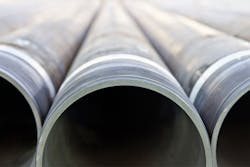The measurement of gas flow in large pipes in a steel mill was discussed in a recent article. Although the article was targeted to a somewhat specific application, the general use of the word "large" begs the question of what the word "large" actually means. Many years ago, I helped start up a steel mill with a large 6,000 horsepower (hp) motor that sat on a 2-meter-high pedestal (complete with a stairway and handrail). Some years later, I visited a wind tunnel with a motor rated at more than 100,000 hp. In between, I was led to what was described as a "large" motor that I could not find — until I was instructed to look down where I saw a 25 hp motor at my feet. What a disappointment! I almost tripped over the "large" motor and did not know it.
The word "large" is a relative term that often reflects the previous experience of the person using the word. Based on my experience in steel mills and water systems, the word "large" conjures images of pipes with diameters of more than about 60 inches, although I have worked with flowmeters as large as 180 inches. If I were to limit my experience to the chemical plant in which I worked, "large" might be about 8 inches or so. A person in the pharmaceutical industry may consider 1 inch to be "large."
If you think that this will not happen to you, think again. We commonly use terms that are subjective and open to interpretation. For example, what does "accurate" mean? Conversely, terms that have specific meanings can also be used inappropriately. Has anyone ever told you they would call back in a minute?
I suggest being careful about what you say and wary of what you hear.
David W. Spitzer is a regular contributor to Flow Control magazine and a principal in Spitzer and Boyes LLC which offers engineering, seminars, strategic, marketing consulting, distribution consulting and expert witness services for manufacturing and automation companies. Spitzer and Boyes is also the publisher of the Industrial Automation INSIDER. He has more than 40 years of experience and has written more than 10 books and 350 articles about flow measurement, instrumentation and process control.
Spitzer can be reached at 845-623- 1830 or via spitzerandboyes.com. Click on the "Products" tab to find his Consumer Guides to various flow and level measurement technologies.



